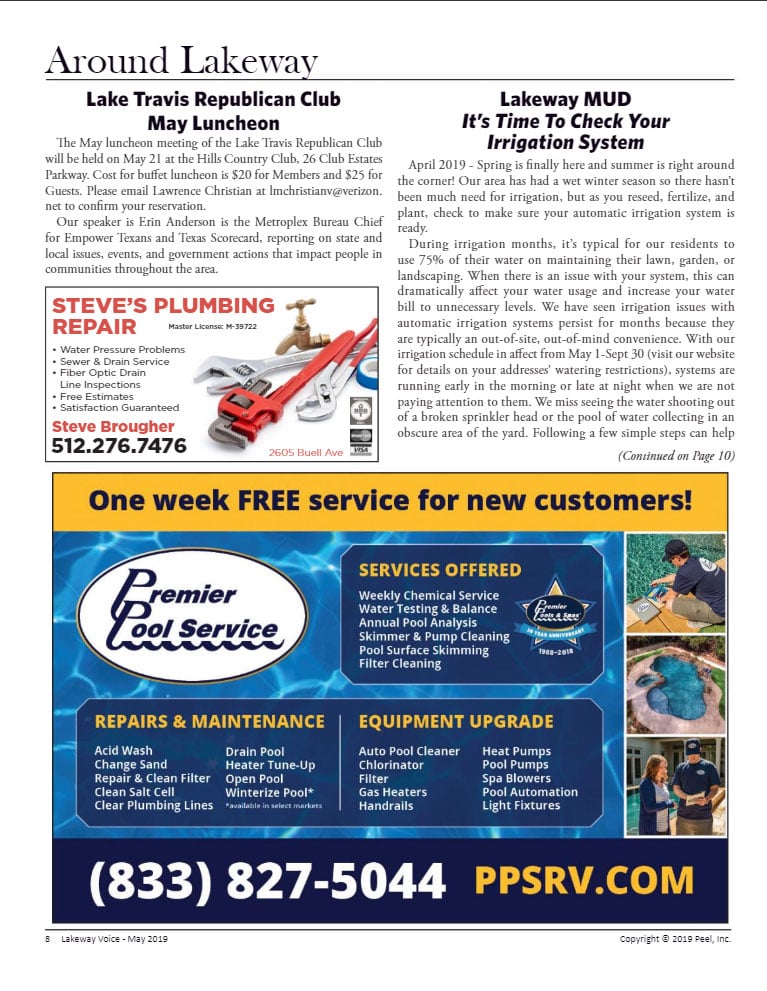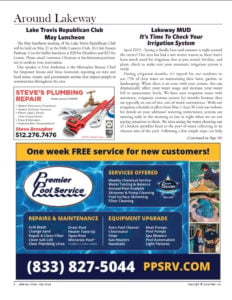It’s Time to Check Your Irrigation System

As published in Lakeway Voice, May 2019 .
Lakeway MUD: It’s Time to Check Your Irrigation System
Spring is finally here and summer is right around the corner! Our area has had a wet winter season so there hasn’t been much need for irrigation, but as you reseed, fertilize, and plant, check to make sure your automatic irrigation system is ready.
During irrigation months, it’s typical for our residents to use 75% of their water on maintaining their lawn, garden, or landscaping. When there is an issue with your system, this can dramatically affect your water usage and increase your water bill to unnecessary levels. We have seen irrigation issues with automatic irrigation systems persist for months because they are typically an out-of-site, out-of-mind convenience. With our irrigation schedule in affect from May 1-Sept 30 (visit our website for details on your addresses’ watering restrictions), systems are running early in the morning or late at night when we are not paying attention to them. We miss seeing the water shooting out of a broken sprinkler head or the pool of water collecting in an obscure area of the yard. Following a few simple steps can help ensure your system is working properly.
We highly suggest that before summer begins, you call an irrigation specialist to check that your system is running smoothly or complete these general tips on your own to help save you money and conserve water with your automatic irrigation system:
1. Walk your yard, checking each sprinkler head: Is it free from debris? Does it appear damaged? Mark and take mental note of where each one is then turn on the system from the control panel and visually inspect each one to confirm it is spraying correctly and in the right direction. When you turn them off, does each sprinkler head depress correctly? Does water continue to leak from it (limited leakage may initially appear to drain water from the pipes, especially if on a hill)? This would also be a good time to check if there are any areas that appear well-watered already (ie: patch of green grass where the rest if brown), which could indicate water leaking from a pipe underground.
2. Check your irrigation control panel (location will vary per house): Is it free from debris? Do you have your watering days and times input correctly in the controller (odd number address Wednesdays and Saturdays; even numbered address Thursdays and Sundays)? Do the backup batteries (if any) need replacing? Are there any wires that appear to be damaged?
3. Locate the valves, which will be in an access box buried in your yard near the irrigation control panel, and open it to inspect for any leakage. Valves should be in the closed position.
4. Once you run a full cycle on your system, walk your yard: check for any soggy spots or pools of water. If you have a leaking pipe, this may be far from the site of a sprinkler head. You may also want to check if there are any dry areas where sprinkler heads are not reaching, where one may need to be directionally adjusted.
If at any time throughout this inspection process you notice anything unusual, call an experienced local irrigation professional to help you. If your system seems to be working correctly but you are still unsatisfied with your water bill, give us a call to request a water profile, which we offer free of charge. We also make an effort to send you a letter if we notice a spike in your water usage – if it is due to a leak and you are diligent about repairs, we can considerably reduce your affected bill. Just give us a call.
Earl Foster, General Manager, Lakeway MUD
Main Office: 512/261-6222 x110
After Hours Emergency: 512/261-2800
www.LakewayMUD.org




 You are now being redirected to the WaterSmart page.
You are now being redirected to the WaterSmart page.